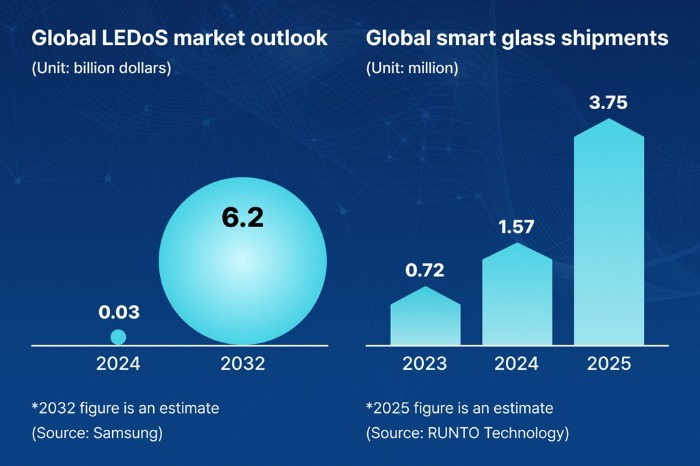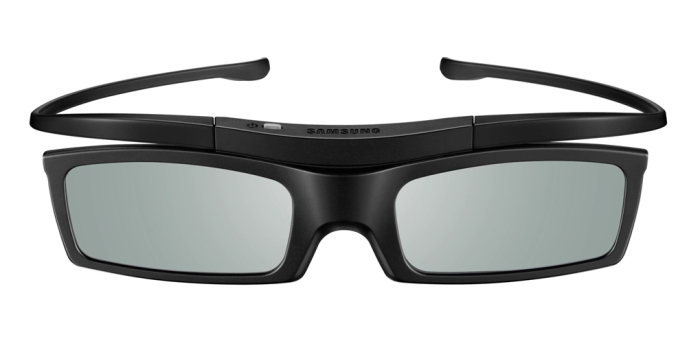Samsung steps up AR race with advanced microdisplay for smart glasses
The S.Korean tech giant is also said to be working to supply its LEDoS products to Big Tech firms such as Meta and Apple
By 15 HOURS AGO
Maybe Happy Ending: A robot love story that rewrote Broadway playbook


When in S. Korea, it’s a ritual: Foreigners make stops at CU, GS25, 7-Eleven


NPS yet to schedule external manager selection; PE firms’ fundraising woes deepen


Seoul appeal: Korean art captivates Indonesia’s affluent connoisseurs


K-pop stocks surge as China set to loosen cultural ban after 9 years



According to industry sources on Wednesday, the South Korean tech giant’s semiconductor division is accelerating its LED on Silicon (LEDoS) technology development, a miniature display platform built on micro-LEDs mounted on silicon wafers.
Samsung is targeting commercial production by 2027, when its mobile division, called Mobile eXperience (MX), is expected to debut its second-generation AR glasses, people familiar with the matter said.
The move pits Samsung against US tech giants such as Apple Inc. and Meta Platforms Inc., both of which are preparing their own AR glasses and are seen as potential future clients for Samsung’s new displays.

STRATEGIC INVESTMENT
As tech giants double down on wearable AR platforms, Samsung’s investment in display innovation could put it at the heart of a competitive new hardware cycle, where screens smaller than a fingernail could shape the next big leap in consumer electronics.
Samsung began scaling up LEDoS development earlier this year following a broader internal reorganization in late 2024.
The company formed a dedicated micro-LED team within its Compound Semiconductor Solutions (CSS) business unit, led by veteran display expert Yoon Seok-ho, who previously spearheaded micro-LED projects.

LEDoS displays offer ultra-high resolution in compact formats and are significantly more power-efficient than traditional panels. With high brightness and low energy consumption, they are particularly suited for AR glasses that must operate in bright outdoor environments and on limited battery capacity.
This technical edge is driving interest among hardware makers looking to build lightweight, wearable AR devices that deliver seamless digital overlays on the real world, industry officials said.
AR GLASSES AT CENTER OF GROWTH STRATEGY
Samsung’s push into LEDoS is underpinned by a bullish long-term market outlook.
Industry forecasts estimate the LEDoS segment will grow from $30 million in 2023 to more than $6.2 billion by 2032.

Samsung officially acknowledged LEDoS as a strategic growth area during its March shareholders’ meeting.
In a company statement, Samsung said AR glasses would be the key driver of LEDoS demand, and that its CSS division would “concentrate resources on next-generation high-margin, high-growth LEDoS displays.”
MX, Samsung’s mobile devices unit, is expected to unveil its first smart glasses model, without a display, as early as 2026, followed by a full-featured AR glasses product in 2027 using in-house LEDoS technology.
In a related move, Samsung and its longtime partner Google LLC are working to unveil new smart glasses to ramp up their collaboration across next-generation platforms, according to sources.

META, APPLE AS NEXT CLIENTS
Samsung is also positioning itself as a future component supplier to rival Big Tech AR projects.
Meta unveiled a prototype of its “Orion” AR glasses last September, with insiders confirming the device uses LEDoS-based displays.
Apple, too, is reportedly working on AR glasses for a 2027 launch window, with CEO Tim Cook said to view the category as a successor to the iPhone.
According to media reports, Apple is exploring both internal development and external collaboration for its LEDoS needs, potentially opening the door to a supplier like Samsung.

Industry watchers said Samsung may shift the LEDoS project to one of its other business units, such as System LSI, or affiliate Samsung Display Co., as it scales toward commercialization.
A Samsung Electronics official said the company has no corporate restructuring plans for now.
In February 2023, Samsung said it is teaming up with Google and Qualcomm Technologies Inc. to venture into the XR device market, which is forecast to grow to $1.7 trillion by 2032 from $131.5 billion in 2024.
XR is a catch-all term that covers technologies like virtual reality (VR) and augmented reality (AR).
Write to Jeong-Soo Hwang at hjs@hankyung.com
In-Soo Nam edited this article.
-
 Tech, Media & TelecomSamsung, Google to unveil smart glasses next year in deeper AI alliance
Tech, Media & TelecomSamsung, Google to unveil smart glasses next year in deeper AI allianceApr 11, 2025 (Gmt+09:00)
3 Min read -
 Tech, Media & TelecomGoogle unveils Android XR platform to launch on Samsung headset
Tech, Media & TelecomGoogle unveils Android XR platform to launch on Samsung headsetDec 13, 2024 (Gmt+09:00)
2 Min read -
 Korean chipmakersSapien Semiconductors looks to overtake Novatek in MicroLED DDI chips
Korean chipmakersSapien Semiconductors looks to overtake Novatek in MicroLED DDI chipsJul 28, 2024 (Gmt+09:00)
2 Min read -
 Tech, Media & TelecomLG ends XR partnership with Meta; Amazon emerges as new partner
Tech, Media & TelecomLG ends XR partnership with Meta; Amazon emerges as new partnerMay 20, 2024 (Gmt+09:00)
3 Min read -
 Tech, Media & TelecomSamsung’s next frontier: XR in partnership with Qualcomm, Google
Tech, Media & TelecomSamsung’s next frontier: XR in partnership with Qualcomm, GoogleFeb 02, 2023 (Gmt+09:00)
3 Min read


